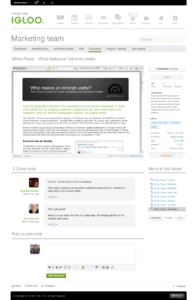Intranetizen – Vendor Profile: Igloo
The Intranetizen team are often asked advice about intranet vendors that supply software and hardware solutions. This week, Sharon O’Dea from Intranetizen recently showcased Igloo Software.
The Intranetizen team are often asked advice about intranet vendors that supply software and hardware solutions to run your intranet. Whilst we have 35 years of blue-chip intranet experience between us, in common with many intranet practitioners, we have relatively limited experience of the 200+ software systems that companies use.
To help you, to help us and to help the vendors themselves, we’re running a series of posts over this week showcasing five intranet companies. We’ve supplied them with the same standard set of questions and will publish their answers in their own words to ensure equity! All the images have been supplied by the company themselves and are reproduced with permission.
Today, we showcase Igloo.
In a brief paragraph, who are you?
Igloo is an intranet your employees will actually use. It’s a digital workplace that brings together content and conversation in one unified environment, so you can share files, find answers, exchange ideas, manage projects and work better together. And because it’s a SaaS solution, it doesn’t have to be managed by IT.
Briefly describe your product’s history? Why did you start it, where does it come from?
In 2004, a think tank called the Centre for International Governance Innovation launched an initiative to bring together the world’s greatest minds in one virtual location to share research and exchange ideas around global governance issues. Since email was ineffective as a collaborative tool, a platform – known as Igloo – was architected to connect these researchers.
The platform was so successful that in 2008, Igloo was spun out of CIGI as a cloud-based solution for social collaboration. Today, Igloo powers over 4,000 global collaboration sites in more than 80 countries worldwide. You can view a sample of those customers on our website.

Describe your typical customer – what kind of company, what size, what are the kinds of problems they need to solve?
Igloo’s ideal customer is a distributed organization where employees need to co-create, discuss or share information with their colleagues or customers.
In terms of the typical organization, the need for virtual collaboration is not restricted to a specific size organization nor is it limited by geography. It could be a small business whose operations spread across multiple cities or countries and is seeking to better coordinate its efforts. Or, it could be an enterprise that is struggling with information silos and knowledge sharing.
Remember, even if you’re under the same roof, the fifty-foot rule applies – people are not likely to collaborate very often if they are more than 50 feet apart. They need the right tools – email, conference calls and shared drives just don’t cut it.
What do you see as your product and company’s USP?
Once upon a time, work was the building we travelled to each and every day. It was the place we went to in order to get work done. But, for many reasons, our perspective on what defines work is changing. Work is not a place anymore – it’s just what we do. We work at the office, but we also work on the road and at home. Igloo is a web-based solution that allows you to work closer together, even when you’re apart. It’s a digital workplace that brings together your content and conversations, so that you don’t have to alt-tab between applications just to collaborate on a document or provide an update.
And, because we support both internal and external collaboration, we have the unique ability to network multiple communities together around business units, teams or audiences.
Which feature(s) of your product do your customers rave about most?
The number of ways in which we share information has exploded over the last few years, with the introduction of blogs (both the long and micro form), wikis and forums. But the creation, editing and review of documents are still the primary way in which we collaborate.
Our customers rave about how their world changes once they stop sharing files as attachments. It sounds simple, but with an HTML5 uploader for drag-and-drop sharing, full version control, editorial workflow, permission settings, audit trails and social tools (e.g. comments, rating, follow), document reviews and approvals happen that much faster.
Our customers are also pretty pumped about the potential in social analytics and our integration with MicroStrategy’s business intelligence platform. For the first time, they have visibility into the conversations and activities that occur within their organizations. Just imagine being able to identify where social interactions are most effective and modeling those broadly across the organization. We’ve never thought about the intranet this way before, but it could be huge.
Which feature(s) of your product do you feel are most under-used?
Multilingual is a relatively new feature that allows the user to select their preferred language and share content, via instant and verified translations, in their native tongue. And I would say that it could be perceived as under-used in an intranet setting as it really comes down to culture.
For instance, NII Holdings gives their human resource and internal communication teams the freedom to communicate in their language of choice (English, Spanish or Portuguese) to build trust amongst the teams, while other multicultural organizations default to English as the primary language for business collaboration. It really just depends on the company.
How much customisation does your product typically need / how much to you recommend your customers make?
Igloo is built with enterprise requirements in mind, but simple enough to set-up in a matter of minutes. Interface design, layout and interactivity can be accomplished right in the browser. It is intuitive and user-friendly, so any employee can easily set up and manage the intranet – no dedicated IT administrators necessary.
You can set-up, configure and brand the intranet using the control panel, widgets and the WYSIWYG editor, taking advantage of the inherent flexibility of the software rather than relying upon code changes or complex customizations. For the more technically inclined, global CSS, HTML and an open, REST-based API mean a little bit more time, but even greater control.
Not convinced? Everyone has an equal opportunity to try it themselves: igloosoftware.com/try.

Even as a software company, we understand that technology in of itself is not the solution. There are operational and cultural forces at play which will impact the success of your intranet. That’s why it’s so important for any search to be driven by or have input from the business.
Start any intranet platform search by clearly defining your goals and objectives first. Where are we now? Do we have an intranet? Are we simply using it as a document repository? What has triggered the need for change?
Then, define the desired business outcomes. Are you seeking to deliver consistent information to all employees? Improve the efficiency of collaboration? Support employee connections by enabling networking? Promote strong alignment to the culture?
With this information in hand, it will be far easier to set the proper requirements and prioritize the features that will be needed to support these outcomes. And, by bringing both IT and business users to the table, you will ensure that all requirements are met from security to usability.
What’s your cost model? Free; one-off; per seat per month charging; something else?
As a SaaS solution, the economics are definitely compelling. There is nothing to install or maintain, and you don’t have to deal with updates, patches or the maintenance of servers. And, as user uptake increases, the process of expanding the implementation is incredibly simple.
Igloo’s license model is subscription based and starts at $12 per user per month (discounts are applied as totals increase). We are very transparent with our pricing, so you can check out the full details on our website which covers license fees, add-ons, integrations as well as professional services.
Who are your main competitors?
Igloo is often seen as an alternative to the traditional enterprise platforms that are characterized by slow innovation, 3 year product release cycles and costly deployments. We also come across organizations that are considering Jive, but need more than a social conversation engine. They’re looking for strong document management and knowledge sharing capabilities as a core component of their social intranet.
What do you need from *your* customers to deliver intranet success?
Two things come to mind.
First, help us define what success means to you. There are so many different ways you can configure an Igloo community, so understanding your goals, objectives and desired business outcomes can be crucial to establishing the right information architecture, structure and design at the outset of the project.
Second, a successful intranet enables a company to talk to itself. That means it’s a very dynamic environment, it’s constantly changing and that requires a commitment to ongoing community management. It’s possible that the gains from social technologies may not persist, so a willingness to continue to work together post-launch in order to make changes and respond to the needs of the user base is critical to ongoing success.
What does the future have in store for your product?
Igloo follows an agile development cycle delivering new product releases and improvements every 90 days. That means the future is never that far away. We’re working on a number of cool things over the coming months, but here are a few:
- Mobile enhancements – introducing responsive design and a next-generation mobile app that supports iOS, Android and Blackberry
- Social task management – adding light-weight management capabilities to turn the intranet into a place to get work done
- Secure instant messaging – building a third-party integration providing presence recognition and the ability to initiate real-time chat right inside the intranet
What does intranet 2015 look like?
We see a convergence occurring between the content and communication tools we use at work. No longer do we need to move between shared folders, email, instant messaging, video and social tools in order to create content and update our teams. The intranet is fast becoming the hub of business collaboration.
By 2015, the intranet will bring together our traditional collaboration tools and core business applications under one roof – enabling us to disconnect from the physical office without interruption, so no matter where we are, we can connect to the people, processes and information that we need to get our jobs done.
Who should Intranetizen readers speak with to find out more about your product?
Intranetizen readers can connect with Igloo in a multitude of ways. You can call us, email us or chat live with a representative right from any page on our website. We’re also active in social channels, so you can also tweet us directly @IglooSoftware.
If you’re not ready to chat but eager to test the product, we offer a number of ways to try Igloo, including a self-service trial, full service trial or paid proof of concept.
You can also check out the latest analyst reviews from Real Story Group, Gartner or IDC. Often times, we’ll even license these reports and make them freely available in our resource library.
What question should we have asked? And if we had, what would the answer have been?
Maybe – simply – why do intranets fail?: Looking back at their history, the traditional corporate intranet has been a content wasteland – the place where documents go to die. And a broadcast tool for a select group of employees to disseminate information that can be consumed by the masses.
Igloo believes in a networked model – an alternative approach to the old, top-down, one-size- fits-all intranet in favor of one that is more distributed and bottom-up. From what we’ve seen, decentralizing ownership and empowering employees by enabling them to be producers, not just consumers of content, is critical to intranet success.
To read the full article, click here.
